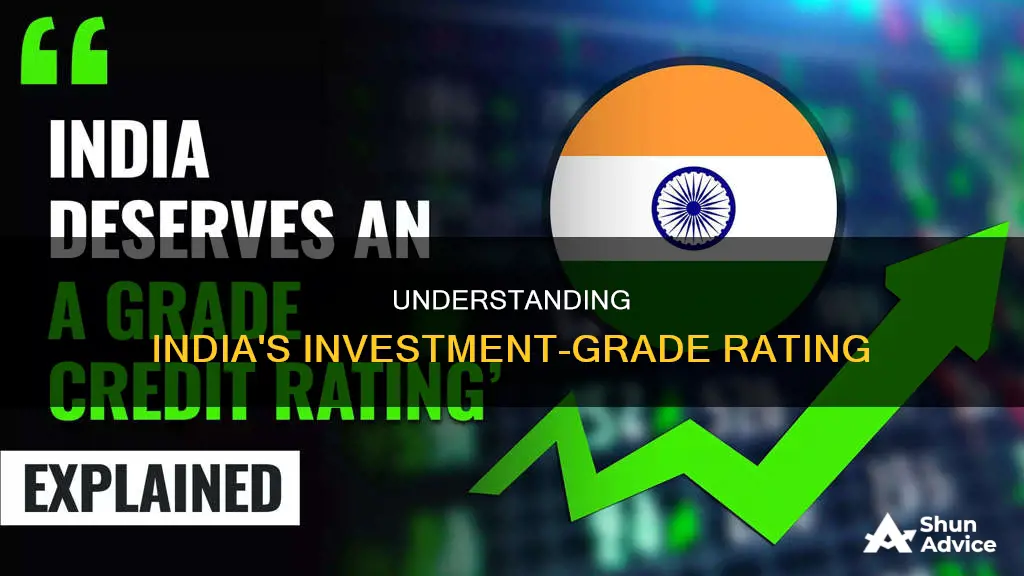
India's credit rating is currently at BBB- for S&P and Fitch and Baa3 for Moody's, which is the lowest investment grade. Credit ratings are determined by comprehensive evaluations conducted by major credit rating agencies such as Standard & Poor's (S&P), Moody's, and Fitch Ratings. These agencies use distinct rating scales and methodologies to assess the economic and financial health of India, taking into account factors such as economic performance, fiscal policies, political stability, and debt levels. A credit rating of BBB- indicates a moderate credit risk for investors, suggesting that the country can meet its financial needs with some risk involved. This rating has implications for India's borrowing rates and how investors view the country.
| Characteristics | Values |
|---|---|
| Credit rating agencies | CRISIL, ICRA, CARE, Standards & Poor, Fitch, Moody |
| Credit rating range | AAA (safest) to C and D (highest default risk) |
| Investment-grade bonds | Rated BBB or higher |
| Junk bonds | Rated BB, B or CCC |
| Credit rating impact | Higher rating means lower yield |
| India's credit rating | BBB- (Fitch, S&P), Baa3 (Moody's) |
What You'll Learn

Investment-grade bonds
Credit rating agencies such as Moody's, Standard & Poor's, and Fitch are responsible for evaluating the risk of default associated with bonds and assigning ratings accordingly. Bonds with ratings of Baa (Moody's) or BBB (S&P and Fitch) or above are considered investment-grade. These ratings indicate that the bonds are relatively low risk and are more likely to be repaid, making them attractive for conservative investors seeking diversification or regular income.
In India, credit rating agencies such as CRISIL, ICRA, and CARE assess the creditworthiness of investment-grade bonds. They evaluate the financial position, credit history, and other factors of the issuer to determine the probability of default. The ratings for investment-grade bonds range from AAA, the highest quality with the lowest risk of default, to BBB, which is considered the lowest acceptable rating for investment-grade.
However, there are also some disadvantages to consider. Investment-grade bonds typically offer lower returns than stocks, which can make it more challenging to meet retirement or investment goals. They may also have lower liquidity, as bonds are usually held until their maturity date. This lack of liquidity can make it difficult to access invested money until the bond matures.
Overall, investment-grade bonds are an important component of a well-diversified portfolio. They provide stability, reliability, and a lower risk of default compared to non-investment-grade or junk bonds. Investors seeking secure and stable investment options often prefer investment-grade bonds, especially those prioritising steady income over high-risk, high-reward opportunities.
Diversifying Savings and Investments: A Smart Money Move
You may want to see also

Credit rating agencies in India
CRISIL
The Credit Rating Information Services of India Ltd. (CRISIL) is a leading credit rating agency in India, with a market share of over 60%. Established in 1987, CRISIL provides a range of rating services, including corporate and financial sector ratings, fund ratings, and recovery risk ratings. The agency uses a rating scale from AAA to D, with AAA denoting the highest creditworthiness and D indicating default. CRISIL is a subsidiary of the global credit rating agency Standard & Poor's.
ICRA
The Investment Information and Credit Rating Agency of India Ltd. (ICRA) is an independent and professional credit rating agency. Founded in 1991, ICRA offers guidance and information to institutional and individual investors. It specialises in assigning corporate governance ratings, mutual fund ratings, and structured finance ratings. ICRA is majorly owned by the international credit rating agency Moody's.
CARE
Credit Analysis and Research Ltd. (CARE) is an experienced credit rating agency established in 1993. CARE provides ratings for companies in various sectors, including infrastructure, manufacturing, and financial services. It offers credit ratings for developing bank debt and capital market instruments such as corporate bonds, debentures, and structured credit. CARE also has wholly-owned subsidiaries, including CARE Advisory and CARE Risk Solutions.
Brickwork Ratings
Brickwork Ratings India Private Ltd. (BWR) is a SEBI-registered and RBI-accredited credit rating agency. It offers rating services on bank loans, fixed deposits, non-convertible debentures, commercial paper, and securitised paper. BWR provides credit ratings for banks, financial institutions, large corporate customers, and state and local governments. Canara Bank is a promoter of Brickwork Ratings.
India Ratings and Research Pvt. Ltd.
India Ratings and Research (Ind-Ra) is a wholly-owned subsidiary of the Fitch Group. It is recognised by SEBI and accredited by RBI. Ind-Ra offers credit rating services to a wide range of entities, including banks, insurance companies, corporate issuers, and leasing companies. The agency operates from its head office in Mumbai and has branch offices in several cities across India.
INFOMERICS Valuation and Rating Private Ltd.
INFOMERICS Valuation and Rating Private Ltd. is a SEBI-registered and RBI-accredited credit rating agency. It provides in-depth analysis and evaluation of the creditworthiness of banks, NBFCs, large corporates, and small and medium-scale units (SMUs). INFOMERICS offers credit rating services for various instruments, such as non-convertible debentures, commercial papers, and securitisation transactions. The agency also rates mutual funds and alternative investment fund schemes.
Other Credit Rating Agencies
In addition to the top agencies mentioned above, there are a few other notable credit rating agencies in India, including Acuite Ratings & Research Ltd., SMERA (Small and Medium Enterprises Rating Agency of India), and Fitch India. These agencies also play a significant role in evaluating and assigning credit ratings to entities in the country.
Opening a Fidelity Investment Portfolio: A Step-by-Step Guide
You may want to see also

How credit ratings affect borrowing costs
Credit ratings play a significant role in determining the borrowing costs for companies and individuals. A good credit rating indicates lower borrowing costs, while a poor credit rating leads to higher borrowing costs. Here's how credit ratings affect borrowing costs:
Impact on Interest Rates
The most direct way credit ratings influence borrowing costs is through interest rates. When an entity or an individual borrows money, the interest rate they are charged is often based on their credit rating. A higher credit rating generally leads to lower interest rates, making the loan more affordable. Conversely, a lower credit rating may result in higher interest rates, increasing the overall cost of borrowing. Lenders use credit ratings to assess the risk of lending to a particular borrower. A good credit rating indicates a lower risk of default, allowing lenders to offer more competitive interest rates.
Access to Financing
Credit ratings can also impact an entity's ability to access financing. A high credit rating makes it easier for companies to obtain loans and issue bonds or other debt instruments. Investors and lenders are more confident in lending to entities with strong credit ratings, knowing that the risk of default is relatively low. On the other hand, a low credit rating may limit the financing options available to a company, as lenders may view them as high-risk borrowers. This can result in higher borrowing costs or even difficulty in obtaining loans.
Cost of Borrowing for Issuing Bonds
For companies that issue bonds, credit ratings have a direct impact on the cost of borrowing. Bonds are rated by credit rating agencies, and a higher rating typically leads to lower interest rates or coupon rates on the bonds. This means that the company will pay less in interest to bondholders. Conversely, a lower credit rating on a bond will result in a higher interest rate, increasing the company's borrowing costs.
Impact on Investment Decisions
Credit ratings also influence the investment decisions of institutional and individual investors. Investors use credit ratings to assess the risk associated with investing in a particular company or security. A high credit rating indicates a lower risk of default, making the investment more attractive to investors. This can lead to higher demand for the company's securities, resulting in lower borrowing costs for the issuer. Conversely, a low credit rating may make it more difficult for the company to attract investors, potentially increasing their borrowing costs.
Effect on Creditworthiness
Credit ratings are a key factor in determining an entity's overall creditworthiness. A high credit rating indicates that a company is financially stable and has a strong history of debt repayment. This positive creditworthiness can lead to more favourable borrowing terms, including lower interest rates and longer repayment periods. On the other hand, a low credit rating may indicate financial instability or a higher risk of default, resulting in higher borrowing costs and more stringent loan terms.
In summary, credit ratings have a significant impact on borrowing costs. A high credit rating generally leads to lower interest rates, increased access to financing, and more favourable loan terms. Conversely, a low credit rating may result in higher interest rates, limited financing options, and higher overall borrowing costs. Therefore, maintaining a good credit rating is crucial for entities seeking to minimise their borrowing costs.
Maximizing Cash Savings: Best Investment Options for You
You may want to see also

India's credit rating
Investment-Grade Bonds
Investment-grade bonds are considered high-quality bonds with a low risk of default. These bonds are typically issued by entities with stable financial positions, a strong history of debt repayment, and a low likelihood of bankruptcy. In India, investment-grade bonds are rated by credit rating agencies using a scale that ranges from AAA, indicating the highest quality and lowest risk, to D, denoting the lowest quality and highest risk. Bonds with a rating of BBB or higher are classified as investment-grade, reflecting their relatively low default risk compared to other bonds.
Impact of Credit Ratings on Bond Yields
The credit rating of a bond directly impacts its yield. A higher bond rating generally leads to a lower yield because these bonds are perceived as less risky. On the other hand, non-investment-grade bonds, often referred to as "junk bonds," carry a higher risk of default and are considered more speculative. As a result, they tend to offer higher yields to compensate investors for the increased risk. For example, a 10-year government bond with a sovereign rating may yield around 7.06%, while a 10-year BBB corporate bond may offer returns of approximately 11-12% per annum.
Significance of Investment-Grade Bonds in India
Investment-grade bonds are crucial for companies and the government in India, as they provide a means to raise funds for their operations. These bonds are particularly well-suited for financing large-scale projects, such as infrastructure development, that require substantial investment. For investors, particularly those seeking stable and secure investment options, investment-grade bonds offer a dependable source of income with a relatively lower risk of default. This makes them attractive to risk-averse investors and retirees looking to protect their savings.
Dynamics of Credit Ratings
It is important to note that a bond's credit rating is not static and can change over time. The financial health of the issuer plays a significant role in determining the rating. If a company or government experiences financial difficulties, their credit rating may be downgraded, indicating an increased risk of default. Conversely, improvements in financial health may lead to an upgrade in the credit rating. Additionally, investors should be mindful of interest rate risk, as an increase in interest rates can lead to a decline in the value of existing bonds, impacting the overall value of a bond portfolio.
In conclusion, India's credit rating system, facilitated by agencies like CRISIL, ICRA, and CARE, plays a vital role in assessing the risk and stability of investment options. Investment-grade bonds, with their low default risk, are a preferred choice for investors seeking stable and secure investments. However, it is important to remember that credit ratings can change, and investors should conduct thorough research and analysis before making any investment decisions.
Investment Options for College Savings: What Are Your Choices?
You may want to see also

How to improve India's credit rating
India's credit rating has been the subject of recent discussions between the country's government and global credit rating agencies. India is currently seeking an upgrade to its sovereign credit rating, which is currently at the lowest possible investment grade. To achieve this upgrade, several factors need to be addressed and improved. Here are some key strategies that can help enhance India's credit rating:
Demonstrate Strong Economic Growth and Resilience: India's economic growth and resilience to external shocks played a crucial role in improving its sovereign credit profile during the COVID-19 pandemic. Continuing to showcase strong and stable economic growth will be essential in enhancing the country's credit rating. This includes maintaining a consistent track record of economic expansion, attracting foreign investment, and diversifying the economy.
Maintain Fiscal Discipline: The Indian government has expressed its commitment to reducing the fiscal deficit as a percentage of GDP. This is a positive step, as fiscal discipline is a critical factor considered by credit rating agencies. By achieving the targeted reduction in the fiscal deficit, India can demonstrate its ability to manage finances effectively, reducing the risk of default and improving its creditworthiness.
Engage in Transparent Communication: The government has been proactively engaging with credit rating agencies, providing them with insights into the fundamentals of the Indian economy, latest economic developments, growth prospects, and reform commitments. This transparent communication helps build trust and confidence among the rating agencies, which can positively influence India's credit rating over time.
Improve Macroeconomic Indicators: Credit rating agencies consider various macroeconomic factors when assessing a country's creditworthiness. India should focus on improving key indicators such as economic growth rate, inflation, general government debt, and short-term external debt as a percentage of GDP. Achieving positive trends and sustainable improvements in these areas will contribute to a stronger credit rating.
Enhance Political Stability: Political stability is another important factor considered by credit rating agencies. A stable political environment reduces uncertainty and enhances a country's creditworthiness. India should strive for consistent and effective policy implementation, maintain a strong institutional framework, and ensure a predictable regulatory environment to boost its credit rating.
Strengthen Debt Repayment Capacity: Credit rating agencies evaluate a country's ability to service its debt. India can improve its credit rating by effectively managing its debt obligations, ensuring timely repayment, and maintaining a sustainable debt-to-GDP ratio. This demonstrates the country's capacity to honour its financial commitments.
By implementing these strategies and maintaining a consistent track record of economic stability, fiscal discipline, and strong governance, India can work towards improving its credit rating. A higher credit rating will not only reduce the country's borrowing costs but also attract more foreign investment, further bolstering India's economic growth and development.
Steps to Become an Investment Manager in India
You may want to see also
Frequently asked questions
An investment-grade rating is a rating given to bonds that carry a low risk of default. They are issued by companies or governments with a stable financial position and a strong history of debt repayment.
Investment-grade bonds are considered safer than non-investment-grade bonds, also known as junk bonds, as they carry a lower risk of default. As a result, they offer a reliable source of income while preserving the investor's capital.
In India, credit rating agencies such as CRISIL, ICRA, CARE, and others evaluate the financial position and credit history of the issuer to assign an investment-grade rating. These ratings reflect the probability of the issuer defaulting on their debt obligations.
A higher bond rating generally results in a lower yield because highly-rated bonds are considered less risky. On the other hand, non-investment-grade bonds are riskier and more speculative, so they tend to offer higher yields to compensate for the increased risk.







